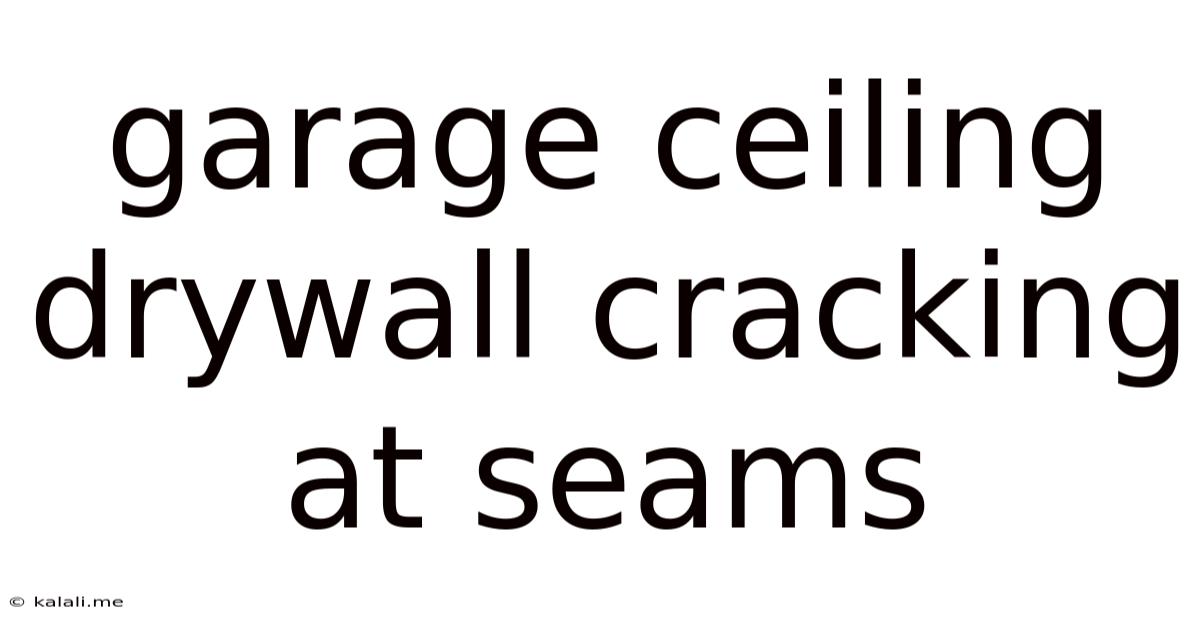Garage Ceiling Drywall Cracking At Seams
Kalali
Jun 10, 2025 · 3 min read

Table of Contents
Garage Ceiling Drywall Cracking at Seams: Causes and Solutions
Meta Description: Dealing with annoying cracks in your garage ceiling drywall? This guide explores common causes like settling, temperature fluctuations, and improper installation, offering practical solutions for repair and prevention.
Garage ceilings, often overlooked in home maintenance, can develop unsightly cracks along the drywall seams. These cracks aren't just cosmetic; they can indicate underlying structural issues or simply poor installation. Understanding the cause is the first step to effective repair and preventing future problems. This article will explore common causes of garage ceiling drywall cracking at the seams and provide practical solutions for both DIY enthusiasts and those seeking professional help.
Common Causes of Garage Ceiling Drywall Cracks
Several factors contribute to drywall cracks, especially at the seams where two pieces of drywall meet. Identifying the culprit is crucial for choosing the right repair method.
-
Settling Foundation: This is a primary cause. As your home settles over time, the foundation shifts subtly, putting stress on the structure, including the garage ceiling. This stress manifests as cracks in the relatively weak drywall seams. This is often seen as larger, more significant cracks, sometimes accompanied by other structural issues.
-
Temperature Fluctuations: Garages experience significant temperature swings, particularly in climates with distinct seasons. These variations cause the drywall to expand and contract, leading to stress on the seams, eventually resulting in cracks. This is more common in older garages with less insulation.
-
Moisture Damage: Leaks, either from the roof or plumbing, can saturate the drywall, causing it to swell and then shrink as it dries. This process weakens the drywall and creates stress points, leading to cracking, often around the seams.
-
Improper Installation: Incorrectly installed drywall, including insufficient mudding and taping, weak joint compound, or improper fastening, can lead to cracks, especially along the seams. This is particularly relevant if the garage was recently built or renovated.
-
Vibration: Heavy machinery or significant vibrations from nearby construction can also cause stress on the drywall seams, leading to cracking.
Diagnosing the Problem: Identifying the Crack Type
Before attempting a repair, carefully examine the cracks. Understanding the type of crack can provide clues about the underlying cause.
-
Hairline Cracks: These small, thin cracks often indicate minor settling or temperature fluctuations. They are typically less concerning than larger cracks.
-
Large Cracks: Wider cracks, often accompanied by significant movement, suggest more serious structural issues requiring professional assessment.
-
Step Cracks: These cracks appear stepped or jagged, indicating movement or significant stress on the drywall.
Repairing Garage Ceiling Drywall Cracks
The repair method depends on the severity of the crack.
For Hairline Cracks:
- Clean the Crack: Remove loose debris and dust using a wire brush or scraper.
- Apply Joint Compound: Use a flexible joint compound and a putty knife to fill the crack. Apply multiple thin coats, allowing each coat to dry completely before applying the next. Feather the edges for a smooth finish.
- Sand Smooth: Once dry, sand the repaired area smooth using fine-grit sandpaper.
- Prime and Paint: Apply a primer to ensure proper paint adhesion and then paint to match the existing ceiling.
For Larger Cracks:
Larger cracks may require more extensive repair, possibly involving removing and replacing sections of the drywall. For significant or recurring cracks, it's best to consult a professional drywall contractor to rule out structural issues.
Preventing Future Cracks
Preventative measures can significantly reduce the likelihood of future cracking.
- Insulate the Garage: Proper insulation helps minimize temperature fluctuations, reducing stress on the drywall.
- Address Leaks Promptly: Repair any leaks in the roof or plumbing immediately to prevent moisture damage.
- Maintain Proper Humidity: Excessive humidity can weaken drywall. Use a dehumidifier if necessary.
By understanding the causes of garage ceiling drywall cracking and employing appropriate repair and preventative measures, you can maintain the integrity and appearance of your garage ceiling for years to come. Remember, for significant cracks or recurring issues, professional assessment is always recommended.
Latest Posts
Latest Posts
-
How Many 12 Oz Cans In A 2 Liter
Jul 01, 2025
-
How Many Quarts Is 2 Cubic Feet
Jul 01, 2025
-
How Many Seconds Is In 2 Minutes
Jul 01, 2025
-
How To Beat Level 7 Of Bloxorz
Jul 01, 2025
-
All Of The Following Are Responsibilities Of Derivative Classifiers Except
Jul 01, 2025
Related Post
Thank you for visiting our website which covers about Garage Ceiling Drywall Cracking At Seams . We hope the information provided has been useful to you. Feel free to contact us if you have any questions or need further assistance. See you next time and don't miss to bookmark.